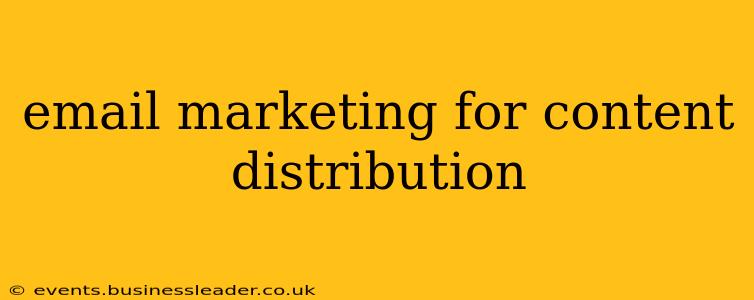Email marketing remains a potent tool for content distribution, even in today's fast-paced digital landscape. Its ability to directly connect with your target audience, nurture leads, and drive engagement makes it an invaluable asset for any content strategy. This post delves into the effective use of email marketing to distribute your content, maximizing reach and impact.
Why Use Email Marketing for Content Distribution?
Before diving into strategies, let's establish why email marketing stands out as a superior method for content dissemination. Unlike social media, where algorithms constantly shift and organic reach can fluctuate, email provides a direct line to your subscribers' inboxes. This means your content is less susceptible to the whims of platform changes and has a higher likelihood of being seen by your intended audience. Furthermore, email allows for personalization and segmentation, enabling you to tailor your message and content to specific groups, maximizing engagement and conversion rates.
Crafting Compelling Email Campaigns for Content Distribution
Creating successful email campaigns requires more than simply blasting out links to your latest blog post. Here's a breakdown of key elements for impactful content distribution through email:
1. Segmentation: The Key to Personalized Engagement
Don't treat all your subscribers the same. Segment your list based on demographics, interests, purchase history, or engagement levels. Sending relevant content to specific segments significantly boosts open and click-through rates. For example, if you have a blog post about sustainable fashion, send it only to the segment of your audience who have previously shown interest in eco-friendly products.
2. Subject Lines that Grab Attention
Your subject line is the gateway to your email's success. It needs to be concise, compelling, and intriguing enough to entice recipients to open it. A/B test different subject lines to see what resonates best with your audience. Consider using numbers, questions, or a sense of urgency to pique their interest.
3. Highlighting the Value Proposition
Don't just send a link; explain why your content is valuable to the recipient. In the email body, briefly summarize the key takeaways, benefits, or solutions offered in your content. This pre-sells the value and encourages clicks.
4. Call to Action (CTA): Guide Your Readers
A clear and compelling call to action is crucial. Tell your readers exactly what you want them to do – read the blog post, watch the video, download the resource. Use strong action verbs and make the CTA visually prominent.
5. Optimizing for Mobile
A significant portion of emails are opened on mobile devices. Ensure your emails are responsive and mobile-friendly, offering a seamless reading experience across all devices.
Types of Content to Distribute via Email
The beauty of email marketing for content distribution lies in its versatility. Almost any type of content can be effectively promoted via email. This includes:
- Blog posts: Share your latest insights and industry news.
- Videos: Promote tutorials, webinars, or product demos.
- Infographics: Share data-rich content in an easily digestible format.
- Ebooks and white papers: Offer in-depth resources to nurture leads.
- Case studies: Showcase your successes and build credibility.
- Webinars and online events: Promote upcoming events and drive registrations.
Measuring Success and Optimizing Your Strategy
Don't just send emails and hope for the best. Track your key performance indicators (KPIs) to measure the success of your campaigns. Analyze open rates, click-through rates, conversions, and unsubscribes to identify what's working and what needs improvement. Use this data to refine your strategy, improve your content, and optimize your email campaigns for better results.
Frequently Asked Questions (PAAs)
How often should I send email newsletters for content distribution? There's no one-size-fits-all answer. Experiment to find the optimal frequency for your audience. Too many emails can lead to unsubscribes, while too few might mean your content gets overlooked. Consider a weekly or bi-weekly schedule as a starting point.
What are some best practices for email design for content distribution? Use a clean, uncluttered layout, high-quality images, and clear font choices. Maintain brand consistency and ensure your emails are visually appealing and easy to read on various devices.
How can I improve my email open rates? A compelling subject line is key. Also, segment your audience and personalize your emails. A/B test different subject lines and email content to see what performs best.
What tools are available to help with email marketing for content distribution? Many tools are available, including Mailchimp, Constant Contact, Sendinblue, and more. Each offers varying features and pricing plans to suit different needs and budgets. Choose a tool that aligns with your specific requirements.
By implementing these strategies and consistently monitoring your results, you can harness the power of email marketing to effectively distribute your content, engage your audience, and achieve your marketing goals. Remember, a well-executed email marketing strategy is a continuous process of learning, adapting, and optimizing.
